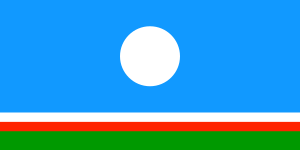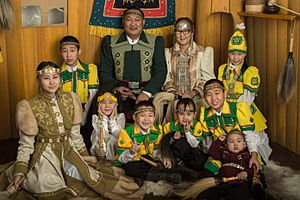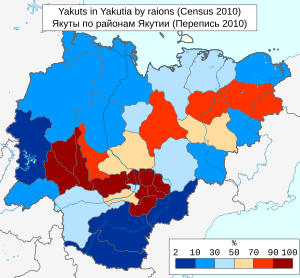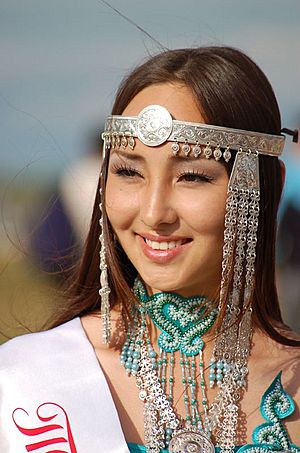Yakuts facts for kids
| Саха | |
|---|---|

Flag of Yakutia
|
|

A Yakut family
|
|
| Total population | |
| Around 500,000 | |
| Regions with significant populations | |
| 478,085 (2010 census) | |
| 415 (2009 census) | |
| 304 (2001 census) | |
| 37 (2021 statistics) | |
| Languages | |
| Yakut, Russian | |
| Religion | |
| Shamanism, Eastern Orthodoxy | |
| Related ethnic groups | |
| Dolgans, Tuvans, Khakas, Altay, Mongols and Buryats (partially, possibly through Kurykans), Xiongnu, other Turkic people | |
The Yakuts, also known as the Sakha (Yakut: саха), are a group of Turkic people who mostly live in the Republic of Sakha in Russia. Some Yakuts also live in other parts of Russia like the Amur and Magadan regions. Their language, Yakut, is part of the Siberian branch of Turkic languages. The word "Yakut" comes from the Evenk word yokō. The Yakuts call themselves Sakha.
Contents
Who are the Yakuts?
Where do the Yakuts come from?
Many experts believe the ancestors of the Yakuts were the Kurykans. These people moved from the Yenisey River to Lake Baikal. Later, around the 13th century, they moved again. They settled in the areas around the Middle Lena, Aldan, and Vilyuy rivers. This move happened because of pressure from the growing Mongol Empire.
The Yakut people formed when these Turkic-speaking groups mixed with local people. These local groups included the Yukaghir and Tungus people who already lived near the Lena River. This mixing helped create the unique Yakut culture and language we see today.
Some Yakut groups, like the Khoro, have special stories about their origins. Their folklore often features the Raven as an important ancestor or deity. This is similar to stories found in other cultures around the Bering Sea.
A Look at Yakut History
How did the Yakuts interact with Imperial Russia?
In the 1620s, the Russian Tsardom started moving into Yakut lands. They took control and began collecting a fur tax called yasak. This led to several Yakut rebellions between 1634 and 1642. The Russian forces, led by voivode Peter Golovin, responded harshly. They burned villages and killed many people. It's thought that the Yakut population dropped by about 70 percent between 1642 and 1682. This was mainly due to diseases like smallpox.
By the 18th century, Russia changed its approach. They gave some privileges to Yakut chiefs and allowed them more freedom. They also sent Orthodox missions and taught Yakuts about farming. The discovery of gold and the building of the Trans-Siberian Railway brought more Russians to the area. Many Yakuts officially became Orthodox Christians, but they still kept many of their traditional shamanist practices.
What happened during the Russian Civil War and Soviet times?
The Russian Civil War had its last major conflict in Yakutia. This was called the Yakut Revolt. A White Russian officer named Mikhail Korobeinikov led an uprising against the Red Army.
In 1922, the new Soviet government created the Yakut Autonomous Soviet Socialist Republic. However, in the late 1920s and 1930s, the Yakut people faced hard times. Joseph Stalin's collectivization policies led to hunger and hardship. The Yakut population decreased during this period, but it began to recover by 1972.
Yakuts in Modern Russia
Today, Yakuts make up a large part of the population in the huge Sakha Republic. According to the 2010 Russian census, there were about 466,492 Yakuts living there. This was almost half of the republic's total population.
Yakut Culture and Traditions
The Yakuts are known for their animal farming. They traditionally raise horses, especially the strong Yakutian horse. They also herd reindeer and special Yakutian cows. These animals are well-suited to the cold local weather.
Certain rock formations and places like Ynnakh Mountain are very important to the Yakuts. They hold these places in high regard.
Delicious Yakut Food
Yakut food uses a lot of dairy products from cows, mares, and reindeer. A traditional drink is kumis, made from fermented mare's milk. They also enjoy stroganina, which is thinly sliced frozen salted fish. Other popular dishes include meat loaves, venison, and frozen fish. Thick pancakes and salamat, a millet porridge with butter and horse fat, are also common.
For dessert, Kuerchekh is popular. It's made from cow milk or cream with different berries. Indigirka is a traditional fish salad. These foods are unique to the Yakutia region.
The Yakut Language
Most Yakuts in the Sakha Republic speak the Yakut (or Sakha) language. About 87% of them are fluent in it. Also, 90% of Yakuts are fluent in Russian. The Yakut language is part of the Northern branch of the Siberian Turkic languages. It is very similar to the Dolgan language and has some links to Tuvan and Shor.
Famous Yakut People
Academics
- Georgiy Basharin, a professor at Yakutsk State University
- Zoya Basharina, also a professor at Yakutsk State University
Artists
- Evgenia Arbugaeva, a photographer
Actors
- Anna Kuzmina, an actress
Military Heroes
- Vera Zakharova, a pilot during World War II
- Valery Kuzmin, a Soviet pilot
- Fyodor Okhlopkov, a Soviet sniper
Models
- Natalya Stroeva, who was Miss Russia 2018
Musicians
- Kjuregej, an artist and musician
- Sarantuya, a mezzo-soprano singer
Political Leaders
- Yegor Borisov
- Aysen Nikolayev
- Mikhail Nikolayev
Historical Rulers
- Tygyn Darkhan, a king of the Yakuts
Sports Stars
- Georgy Balakshin, a boxer
- Vasilii Egorov, a boxer
- Pavel Pinigin, an Olympic champion wrestler
See also
 In Spanish: Yakutos para niños
In Spanish: Yakutos para niños



